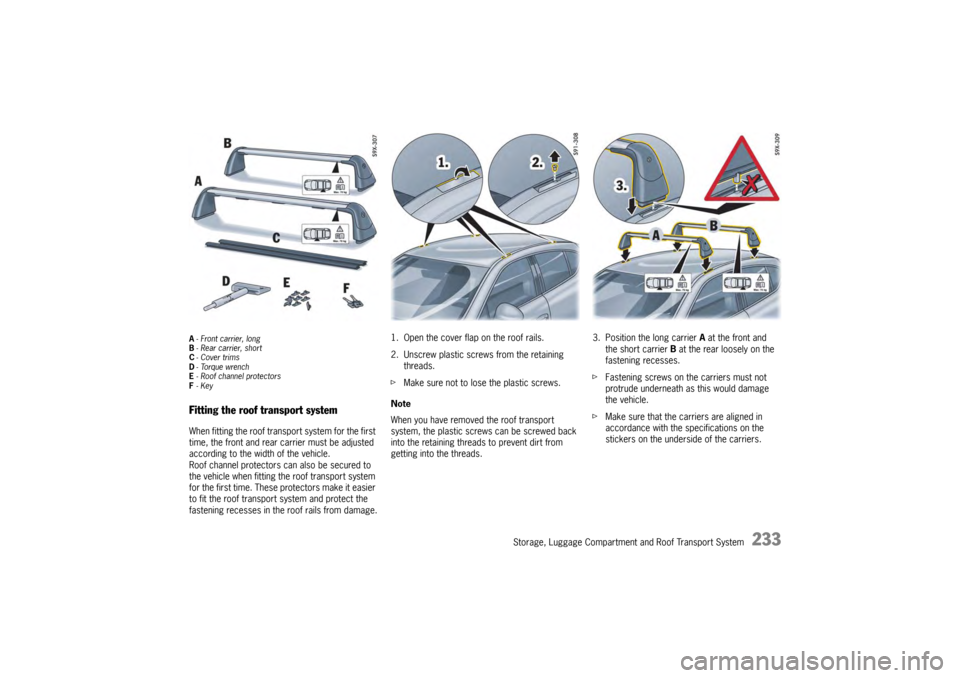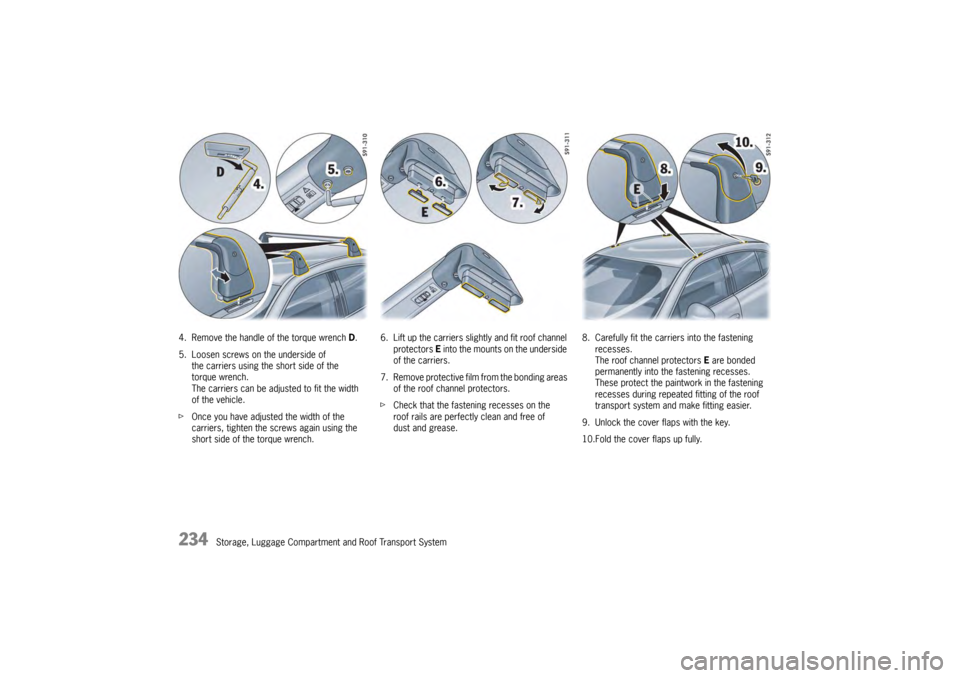2009 PORSCHE PANAMERA width
[x] Cancel search: widthPage 230 of 343

228
Storage, Luggage Compartment and Roof Transport System
Stowing Loads
Danger!
Danger of injury. An unsecured or incorrectly
positioned load can slip out of place or
endanger the vehicle occupants during
braking, direction changes or in accidents.
Never transport objects that are not secured.
f Always transport loads in the luggage
compartment, never in the passenger
compartment (e.g. on or in front of the seats).
f Support the load against the seat backrests
wherever possible. Always lock the backrests
into place.
f Only transport heavy objects with the rear seat
backrests upright and engaged.
f Place the load behind unoccupied seats
whenever possible.
f Stow heavy objects as far forward as possible
on the floor, with lightweight objects behind
them.
f Never load the vehicle higher than the top
edge of the seat backrest.
f Always protect the passenger compartment
with a luggage compartment cover. Do not
drive with objects on top of the luggage
compartment cover. f
If the rear seats are not occupied, the
backrests can be addition ally secured with the
seat belts. Simply cro ss the outer seat belts
and insert each into the opposite buckle.
f Make sure that the load cannot damage the
heating filaments and the TV antenna in the
rear window.
Tie-down belts
f Do not use elastic belt s or straps to tie
down a load.
f Do not route belts and straps over
sharp edges.
f Observe the directions for use and information
for the tie-down equipment.
f Use only belts with a tear strength of at least
1543 lbs (700 kg) and a maximum width of
1 in. (25 mm).
f Cross the belts over the load. Driving
f
Vehicle handling changes depending on the
vehicle load. Adapt your driving style to the
changed driving behavior.
f Do not exceed the maximum gross weight
and axle load.
This information can be found under “Technical
data” in this Owner’s Manual:
f Please see the chapter “WEIGHTS” on
page 328.
f Never drive with the tailgate open. Exhaust
gases can enter the passenger compartment.
f Adapt the tire pressure to the load.
After you change the tire pressure, you must
also update the setting for Tire Pressure
Monitoring.
For information on setting Tire Pressure
Monitoring on the multi-function display:
f Please see the chapter “OVERVIEW OF
WARNING MESSAGES” on page 152.
Information on tire pressures for partially and fully
loaded vehicles can be found under “Technical
data” in this Owner’s Manual:
f Please see the chapter “TIRE PRESSURE FOR
COLD TIRES (68 °F/20 °C)” on page 326.
Page 234 of 343

232
Storage, Luggage Compartment and Roof Transport System
Roof Transport SystemA roof transport system can be fitted on the
vehicle for transporting awkward objects.
Various objects can be transported safely and
securely using the roof transport system and
additional attachments, e.g. ski rack, bicycle rack,
surfboard rack, roof box or snowboard holder.
fOnly use roof transport systems that have
been tested and approved by Porsche. It is not
possible to fit commercially available roof rack
systems.
Danger!
Risk of accidents if th e vehicle loses its roof
transport system due to excessive speed or
improper loading.
f Check the roof transport system and
attachments before every journey and at
regular intervals during a long journey to
ensure that they are fitted correctly and
securely. Tighten all fa stening screws again.
f Adjust your driving style accordingly by
maintaining a reasonable speed and slowing
hour vehicle turns.
f Do not drive at a speed of more than
80 mph (130 km/h) when the roof transport
system is fitted and loaded.
f Do not drive at a speed of more than
110 mph (180 km/h) when the roof transport
system is fitted but not loaded. Obey all traffic
laws.
f Load the roof transport system so that the
load does not protrude over the sides of the
roof transport system.
Never load the roof transport system wider
than the width of the vehicle.
f Position the center of gravity of the load as low
as possible with respect to the roof transport
system and distribute the load evenly over the
load area.
f Secure the load so that it will not move during
the journey.Do not use elastic rubber tensioners.
Caution!
Washing the vehicle in a car wash or failure
to observe the overall vehicle height or the
maximum permitted gross weight can
damage the vehicle or roof transport system.
f Remove the complete roof transport system
before washing the vehicle in a car wash.
f Check the overall vehicl e height with the roof
transport system fitted before driving into
multi-storey car parks, garages, underground
garages and tunnels.
f Do not exceed the maximum roof load,
maximum vehicle weight and maximum
axle loads.
For information on maxi mum permitted loads and
weights:
f Please see the chapter “WEIGHTS” on
page 328.
f Do not exceed the maximum permitted roof
transport system load of 70 kg.
f If you are not using the roof transport system,
remove it completely from the vehicle in order to save fuel and reduce noise.
Page 235 of 343

Storage, Luggage Compartment and Roof Transport System
233
A- Front carrier, long
B -Rear carrier, short
C -Cover trims
D - Torque wrench
E - Roof channel protectors
F -KeyFitting the roof transport systemWhen fitting the roof transport system for the first
time, the front and rear carrier must be adjusted
according to the width of the vehicle.
Roof channel protectors can also be secured to
the vehicle when fitting the roof transport system
for the first time. These protectors make it easier
to fit the roof transport system and protect the
fastening recesses in the roof rails from damage. 1. Open the cover flap on the roof rails.
2. Unscrew plastic screws from the retaining
threads.
f Make sure not to lose the plastic screws.
Note
When you have removed the roof transport
system, the plastic screws can be screwed back
into the retaining threads to prevent dirt from
getting into the threads. 3. Position the long carrier
A at the front and
the short carrier B at the rear loosely on the
fastening recesses.
f Fastening screws on the carriers must not
protrude underneath as this would damage
the vehicle.
f Make sure that the carriers are aligned in
accordance with the specifications on the
stickers on the underside of the carriers.
Page 236 of 343

234
Storage, Luggage Compartment and Roof Transport System
4. Remove the handle of the torque wrench D.
5. Loosen screws on the underside of
the carriers using the short side of the
torque wrench.
The carriers can be adjusted to fit the width
of the vehicle.
f Once you have adjusted the width of the
carriers, tighten the screws again using the
short side of the torque wrench. 6. Lift up the carriers slig
htly and fit roof channel
protectors E into the mounts on the underside
of the carriers.
7. Remove protective film from the bonding areas of the roof channel protectors.
f Check that the fastening recesses on the
roof rails are perfectly clean and free of
dust and grease. 8. Carefully fit the carriers into the fastening
recesses.
The roof channel protectors E are bonded
permanently into the fastening recesses.
These protect the paintwork in the fastening
recesses during repeated fitting of the roof
transport system and make fitting easier.
9. Unlock the cover flaps with the key.
10.Fold the cover flaps up fully.
Page 282 of 343

280
Minor Repairs
Tires and WheelsThe original equipment tires and wheel rims on
your Porsche comply with all applicable Federal
Motor Vehicle Safety Standards.
For your safety remember the following:
– Wheel rims and wheel bolts are matched to fit your Porsche.
– If you intend to use other than original equipment wheels, be su re that they conform
to Porsche specifications for your model. Only
tires with the same make and with the same
specification code (e.g . ”N0“, ”N1“...) can be
mounted.
– The use of wheel rims and wheel bolts that do not meet specifications of the original factory
installed equipment will affect the safe
operation of your vehicle and affect warranty
coverage.
– Before you plan on exchanging wheels, or snow tires already mounted on the wheel rims,
consult your authorized Porsche dealer.
Your dealer has the technical information
necessary to advise you which wheel rims and
wheel bolts are compatible with the original
factory installations.
Danger!
Risk of loss of control and serious personal
injury or death.
f If while driving, your vehicle experiences a
sudden vibration or ride disturbance, and/or
you suspect that possible damage to your tires
or vehicle has occurred, you should
immediately reduce your speed without
excessive use of the brakes.
f Stop the vehicle as soon as possible, and
inspect the tires.
If you cannot determine the cause for the
disturbance, have your vehicle towed to the
nearest Porsche or tire dealer to have your
vehicle or tire(s) inspected.
f Continuing to operate the vehicle without
correction could result in a loss of control and serious personal injury.
ExampleUniform Tire Quality GradingQuality grades can be found where applicable on
the tire sidewall between tread shoulder and
maximum section width.
All passenger car tires must conform to Federal
Safety Requirements in addition to these grades.
Page 290 of 343

288
Minor Repairs
Snow chains
Warning!
Risk of damage to body, axle or brake
components.
f Use only the fine-link snow chains recom-
mended and authorized by Porsche so that
sufficient clearance between the wheel well
and the chain is assured.
f Please see the chapter “WHEELS, TIRES” on
page 325.
f Follow instructions issued by the supplier of the chains.
Fit snow chains only on the rear axle.
f Remove spacers if snow chains are mounted.
f Before fitting chains, remove accumulated ice
and snow from the wheel well.
f Vehicles with snow chains must not be driven
faster than 30 mph (50 km/h) .
Different states and countr ies have varying statu-
tory requirements regarding maximum speed.
f Check with local authorities for possible
restrictions.
f Remove chains as soon as the roads are free
of ice and snow.
Example of InscriptionInscription on radial tireA – Tire size
Example: P 265/40ZR18 (101Y)
–P - The tire is designed for Passenger vehicle.
This information is not included on all tires.
– 265 - Indication of tire width in mm
– 40 - Indication of tire height to tire width ratio
in percent
– ZR - Belt type code letter for radial
– 18 - Indication of rim diameter in inches
– 101 - Load capacity coefficient –
Y - Speed code letter
– XL (Extra Load) - Tire with increased load
rating
B – TIN (Tire Identification Number)
Example: DOT xx xx xxxx xxxx
–DOT The DOT symbol indicates that the tires
comply with the requirements of the
US Department of Transportation and provides
information about:
– first two-digit code means manufacture’s identification mark.
Page 291 of 343

Minor Repairs
289
– second two-digit code means tire size.
– third four-digit code means tire type code.
– fourth four-digit code means date of manufacture.
If, for example, the last four numbers read
1204, the tire was produced in the 12th week
of 2004.
C – Tire ply composition and material
The number of layers in the tread and sidewalls
and their material composition.
D – Maximum permissibl e inflation pressure
The maximum permissible cold inflation pressure
to which a tire can be inflated.
f Do not exceed the permissible inflation
pressure.
E – Maximum Load rating
The maximum load in kilograms and pounds can
be carried by the tire. If you replace tires always
use a tire that has the same maximum load rating
as the factory installed tire.
F – Radial
The identification indicates if the tire has radial
structure.
G – Term of tubeless or tube tire
Identification for tubeless tires. Speed code letters
The speed code letter
Y indicates the maximum
permitted speed for the tire.
This code letter is shown on the tire sidewall.
Tip on driving
Tires with a maximum speed rating that is lower
than the specified maximum vehicle speed may be
mounted only if they bear an M+S identification on
the tire sidewall.
f Please note that in addition to snow tires,
all-season tires are also subject to speed limits
and bear this identification.
G- Rim width in inches
H - Rim-flange contour code letter
I - Symbol for drop-center rim
J - Rim diameter in inches
K -Double hump
L - Rim offset in mmInscription on alloy wheelsThe information is inscribed on the back of the
spokes near the tire valve.
T
= up to 118 mph (190 km/h)
H = up to 131 mph (210 km/h)
V = up to 150 mph (240 km/h)
W = up to 167 mph (270 km/h)
Y = up to 186 mph (300 km/h)
(Y) = up to 186 mph (300 km/h) as for Y tires.
Speeds of more than 185 mph
(300 km/h) are also possible at
a maximum tire load capacity of 85 %
(confirmation from tire manufacturer
required for speeds of more than
185 mph (300 km/h)).
Page 332 of 343

330
Tire Pressure and Technical Data
Dimensions
Panamera S, Panamera 4S Panamera Turbo
Length 195.67 in. (4970 mm)
76.02 in. (1931 mm)
83.23 in. (2114 mm)
55.83 in. (1418 mm)
114.96 in. (2920 mm)
Width without exterior mirrors
Width with exterior mirrors
Height at DIN curb weight
Wheelbase
Ground clearance at maximum gross weight
3.31 in. (84 mm) 4.41 in. (112 mm)
Tr a c k s
18-inch wheels, front/rear 65.28 in. (1658 mm)/
65.42 in. (1661.6 mm)
19-inch wheels, front/rear 65.20 in. (1656 mm)/64.80 in. (1645.8 mm)
20-inch wheels, front/rear front: 64.80 in. (1646 mm)
rear: 11J x 20 wheel, 64.24 in. (1631.8 mm)
rear: 10.5J x 20 wheel, 64.48 in. (1637.8 mm)